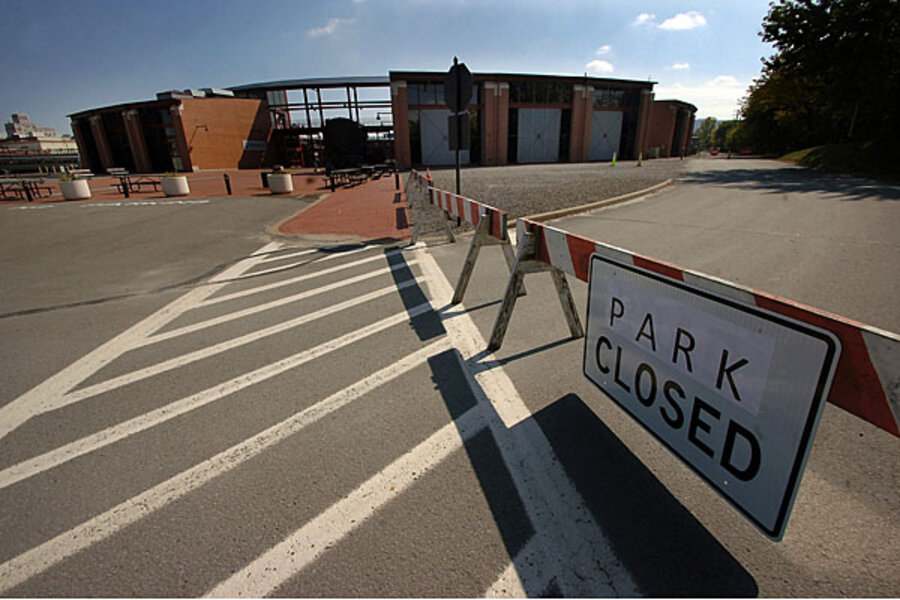The market needs to scare Washington into re-opening government
Loading...
As I write, the S&P is indicating a down-1% open as the shenanigans from Washington have ceased to be cute. I've written about why the markets have been able to shrug the fiscal fight off so far - owing mainly to a sentiment shift after a near limitless rewards program for dip-buyers.
This morning, there are signs that the equity optimism may have reached its limit. If so, I would say that this is a good thing. Every once in awhile, the business world - manifested as the Dow Jones Industrial Average's closing price - needs to remind Washington who the boss is. A sudden 3-5% correction for stock prices would almost certainly send a message strong enough for even the most intransigent pois to notice.
The market needs to scare this congress straight, perhaps. It's certainly worked before.
I'll never forget the afternoon of September 29th, 2008, mainly because I spent it drinking in a bar rather than watching the carnage on my trading screens. The TV in the corner was tuned to CNN which was tuned to the Capitol so that didn't do my fellow brokers and I any good. Like The Notebook on Valentines Day, we were forced to watch it.
That morning, a Monday, Treasury Secretary Hank Paulson had announced a proposed bill that involved the US government buying $700 billion in mortgage backed securities to stabilize the housing market and the banks. The first vote on what would become known as TARP was set for that afternoon and President Bush was confident it would do the trick. Democrats in the House of Representatives voted for it (140–95) while Republicans voted it down (133 against, 65 for) and the legislation failed.
The stock market's judgment was swift and merciless. Wall Street - itself the epicenter of the crisis - was now weighing the effectiveness of our elected officials in Washington - and they had been found wanting. Consider:
The Dow Jones Industrial Average, what Mom and Pop look at when they want a gauge of the stock market (and economy) fell 777 points in the vote's aftermath. We sat on our bar stools stunned. It was the Dow's single worst poin drop ever, with some $1.2 trillion in market value wiped out.
Meanwhile, the S&P 500, what pros pay attention and benchmark to, had lost 8.8% on the session, its seventh worst daily percentage drop of all time and the worst one-day crash since 1987's Black Monday.
The NASDAQ composite, which was almost completely devoid of banks or real estate-related related equities, also posted its worst day since Black Monday that afternoon. It dropped a stunning 9.1%, its third worst day of all time.
Notably, the TED spread, a measure of how much banks trust each other with loaned money, hit a 26-year high of 3.58%.
This was the bloodbath that the pols needed to see, unfortunately. It made headlines around the nation and around the world. Federal Reserve chairman Ben Bernanke met with Congressional leaders, pointed at the destruction and told them the sky would absolutely fall without a bailout. He was right. Inaction was never an option.
A few days later, now scared straight, the Senate passed a revised version on the evening of October 1st with Wall Street's plunge fresh in everyone's minds. The House got another crack at the TARP vote on October 3rd and this time it passed 236-171. 63 Dems and 91 Republicans had still voted no, but common sense triumphed. Bush signed it a few hours later and the markets eventually stabilized (although the bear market was far from over.)
Importantly, the current debate over finalizing a budget and paying the debts we've already accumulated pales in comparison to the life-or-death events of the fall of 2008. However, it's important to remember what happens when the markets begin to show real concern for the inability of congress to function.
A market sell-off here might be just what Washington needs to see, like a juvenile delinquent should occasionally be shown the inside of a prison. We'll see how far it needs to go to make a point.






